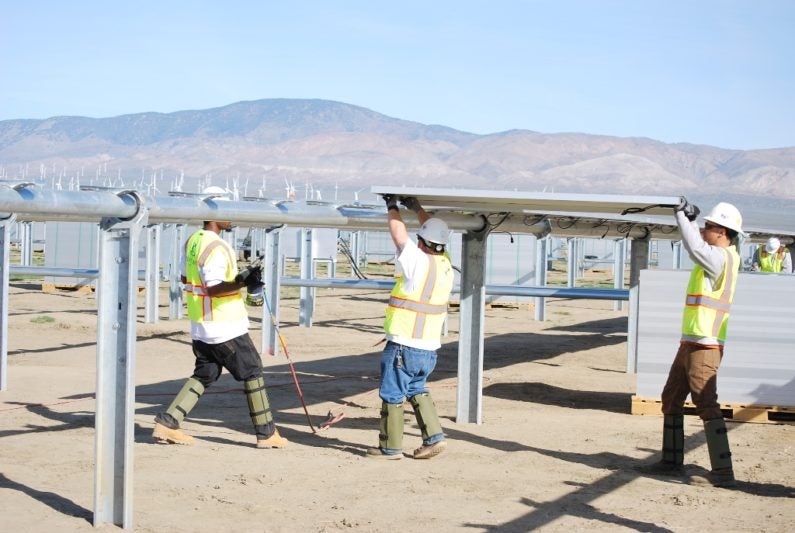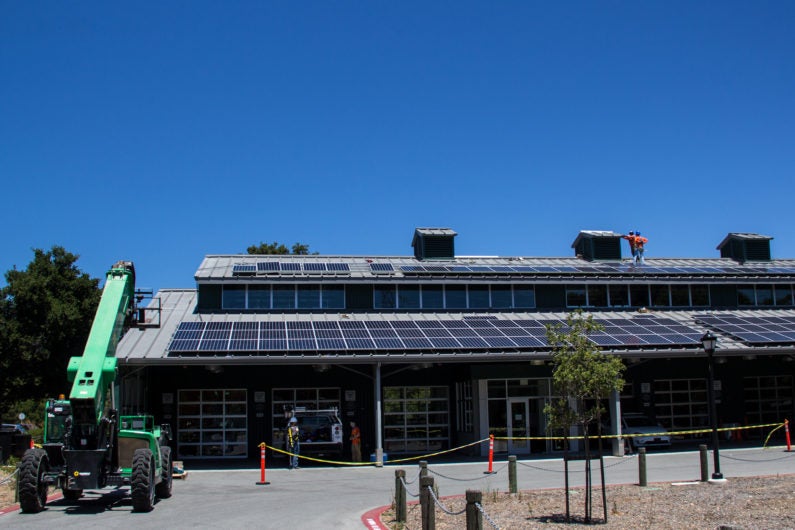Stanford’s solar expansion project moves ahead
By year’s end, a new solar plant will be providing 50 percent of Stanford’s electricity and the campus will be getting 65 percent of its total electricity from renewable sources.
Stanford is moving closer to getting a big dose of its power from the sun.
Work is nearing completion on a new solar plant in Southern California’s Kern County that will provide 50 percent of Stanford’s electricity. The Stanford Solar Generating Station, announced last year, is expected to be functional by the end of November.

Construction of the Stanford Solar Generating Station in Kern County is nearing completion. (Image credit: SunPower)
After a testing period, the plant is expected to be providing power to Stanford on a regular basis by the end of 2016.
In addition, more rooftop solar panels are being installed on campus. Sixteen additional campus buildings – including Maples Pavilion and Bing Concert Hall – are being outfitted with solar panels. That work is expected to be complete later this fall.
After drawing on its new solar resources, Stanford will purchase the balance of its electricity from the larger California power grid, which also is moving toward renewable sources including solar, wind and geothermal. In total, once Stanford’s solar projects are complete later this year, the university will be getting 65 percent of its power from renewable sources – and that proportion will continue increasing in coming years.
“We have been engaged in a major effort to make Stanford one of the most energy-efficient universities in the world, and this expansion of our solar resources will make a dramatic difference,” said Joseph Stagner, executive director of sustainability and energy management at Stanford. “Clean, renewable energy will become the dominant part of Stanford’s energy mix, and its proportion in that mix will continue to grow over time.”
The solar expansion is part of the Stanford Energy System Innovations (SESI), which includes a revolutionary heat recovery system completed last year for the heating and cooling of campus buildings. Together, the heat recovery system and the solar energy resources will reduce Stanford’s greenhouse gas emissions by 68 percent, equivalent to removing 32,000 cars from the road.
The new solar plant under construction, named the Stanford Solar Generating Station, is located on a 242-acre site near Rosamond in the high desert region of Kern County, roughly 300 miles southeast of Stanford. The plant is being built for Stanford by the solar company SunPower.
Construction began in January 2016. The solar panels now have been installed, and work is proceeding on wiring and completing the system. The plant is scheduled to be fully operational and providing power to Stanford on a regular basis by Dec. 31.
When finished, the plant will produce a peak 67 megawatts of power, drawing on more than 150,000 solar panels.
On campus, meanwhile, a new round of rooftop solar installation is proceeding.

Rooftop solar panels are installed on the Automotive Innovation Facility on the Stanford campus. (Image credit: Scott Gould)
Already, several Stanford building complexes feature solar panels, including the Science and Engineering Quad and the Knight Management Center. Installation began in May on rooftop panels for an additional 16 campus buildings to provide an additional five megawatts of power for the Stanford campus.
Among the buildings receiving solar panels are Maples Pavilion, Bing Concert Hall, Kennedy Graduate Residences, Braun Music Center, Central Energy Facility, Center for Clinical Sciences Research, Stanford Auxiliary Library, Stock Farm Garage, Automotive Innovation Facility, HEPL (Hansen Experimental Physics Lab) South, Meyer Buck House and 340 Bonair Siding.
The solar plant plus the campus rooftop panels will produce 53 percent of Stanford’s electricity. The university will purchase the remaining 47 percent from the California electricity grid, of which 25 percent currently comes from renewable power sources. As a result, 65 percent of the university’s power will be from renewable sources by year’s end.
That proportion will continue growing over time because, under state law, the California power grid must move increasingly to renewable sources – 50 percent by 2030.
Additional information on Stanford’s sustainability initiatives is available at sustainable.stanford.edu. Included on the website is the recently released annual report of Sustainable Stanford, highlighting the university’s sustainability actions and achievements from the 2015-16 year.
